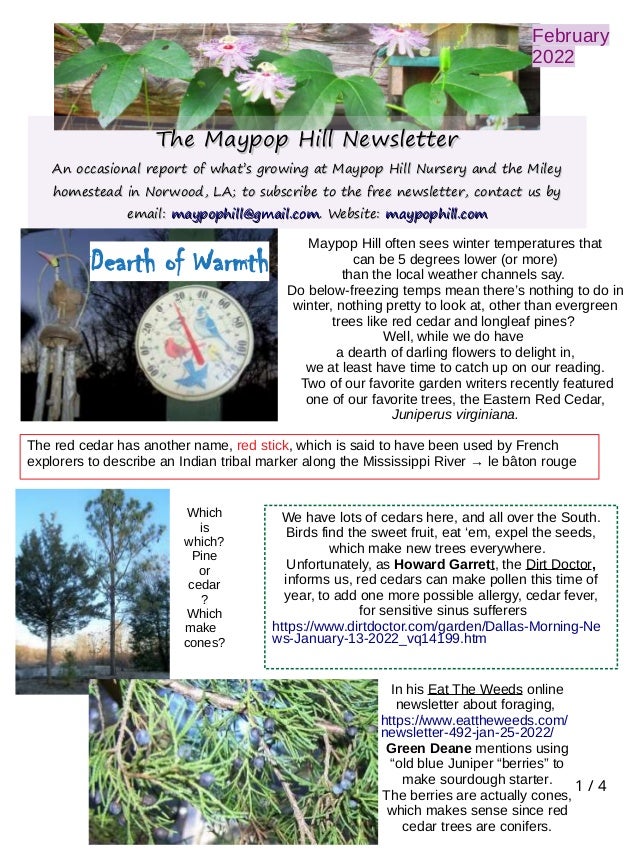
Mh newsletter february 2022
- 1. 1 / 4 The Maypop Hill Newsletter The Maypop Hill Newsletter An occasional report of what’s growing at Maypop Hill Nursery and the Miley An occasional report of what’s growing at Maypop Hill Nursery and the Miley homestead in Norwood, LA; to subscribe to the free newsletter, contact us by homestead in Norwood, LA; to subscribe to the free newsletter, contact us by email: email: maypophill@gmail.com maypophill@gmail.com. Website: . Website: maypophill.com maypophill.com February 2022 Maypop Hill often sees winter temperatures that can be 5 degrees lower (or more) than the local weather channels say. Do below-freezing temps mean there’s nothing to do in winter, nothing pretty to look at, other than evergreen trees like red cedar and longleaf pines? Well, while we do have a dearth of darling flowers to delight in, we at least have time to catch up on our reading. Two of our favorite garden writers recently featured one of our favorite trees, the Eastern Red Cedar, Juniperus virginiana. In his Eat The Weeds online newsletter about foraging, https://www.eattheweeds.com/ newsletter-492-jan-25-2022/ Green Deane mentions using “old blue Juniper “berries” to make sourdough starter. The berries are actually cones, which makes sense since red cedar trees are conifers. Dearth of Warmth We have lots of cedars here, and all over the South. Birds find the sweet fruit, eat ‘em, expel the seeds, which make new trees everywhere. Unfortunately, as Howard Garrett, the Dirt Doctor, informs us, red cedars can make pollen this time of year, to add one more possible allergy, cedar fever, for sensitive sinus sufferers https://www.dirtdoctor.com/garden/Dallas-Morning-Ne ws-January-13-2022_vq14199.htm The red cedar has another name, red stick, which is said to have been used by French explorers to describe an Indian tribal marker along the Mississippi River → le bâton rouge Which is which? Pine or cedar ? Which make cones?
- 2. 2 / 4 A favorite writer of environmentalists, Aldo Leopold (1887-1948), brought wildlife ecology to the attention of a country which was quickly losing its natural plants and animals. In A Sand County Almanac, Leopold observed a disturbing loss of one of the birds he had always hunted, the American Woodcock. In the chapter on these birds, which performed a ‘Sky Dance’ every evening, he decided he would have to limit his hunting of the game birds, so that, “I must be sure that, come April, there be no dearth of dancers in the sunset sky.” No dearth of sky dancers Dearth of ground cover? So what So what will the will the pollinators pollinators eat? eat? Yay! It’s time to start planting seeds. Yay! It’s time to start planting seeds. Veggie seeds, wildflower seeds, even a few tree seeds. Beekeepers plant Dutch White Clover (Trifolium repens) below, to feed their honey bees, the European species which are kept in hive boxes. Since Maypop Hill is trying to restore native bumblebees and butterflies, we bought hard-to-find seeds from Florida to grow Buffalo Clover, Trifolium reflexum . Some botany sites with range maps say that it doesn’t grow in our area; others do. So............. You never know which seeds will grow in your garden row until you sow, sow, sow. A nifty low-growing evergreen, Green and Gold (Chrysogonum virginianum), has turned out to be a nice, dependable ground cover. https://plants.usda.gov/home/ plantProfile?symbol=TRRE2 Red Maple (Acer rubrum) blooms in late winter to early spring, just in time to make nectar and pollen for honey bees and native bees looking for food when temps are over 50 degrees.. . Dearth of seeds? No way Dearth of seeds? No way! !
- 3. 3 / 4 Dearth of Biodiversity? This old file from Maypop Hill’s first book, My Yard, was an early attempt to learn how we could make good use of worn out, badly eroded soil. We’ve incorporated many of the ideas, had lots of flops, but some successes. A version of the pdf is online and downloadable on our website, maypophill.com.
- 4. 4 / 4 Maypop Hill Nursery & Publications 4979 Spec Garig Rd., Norwood, LA Betty & LJ Miley, specializing in native plants of the South email: maypophill@gmail.com web: maypophill.com Geaux native! Dearth of Frogs Toads, turtles, and the occasional turkey have been spotted on Maypop Hill in the last year. But no little tree frogs sticking to windows, or bullfrogs singing in the koi pond. Also, we’ve seen no tadpoles or pollywogs in ditches where they used to be common. Where have all the froggies gone? You let a tasty mosquito in. I’ll get it, ribbit, 2016 Croak, croak You may hear me but you can’t see me, 2015 Could the 2 smart meters on our house and shop be the reason the bats quit flying over our belfry in the evening ? https:www.smartmetereducationnetw ork.com/smart-meter-environmental- effects.php Events we plan to attend - Louisiana Native Plant Society 2022 ANNUAL MEETING, February 4-6, 2022, Wesley Center, Woodworth, LA: LNPS Winter Meeting - the BREC Independence Park Spring Plant Sale, Saturday, April 9th, 2022 from 8AM to 12 noon, 7950 Independence Blvd., Baton Rouge, LA 70806 Dearth of Winter Color ? A Winterberry Holly (Ilex verticillata) outside the front door has been berry berry red since October. Birds are waiting for the fruit to become soft and ripe. A “Florida Sunshine Anise” (Illicium parviflorum) in the in the background has been yellow all year. Technically, the evergreen foliage is chartreuse when the plants get full sun.